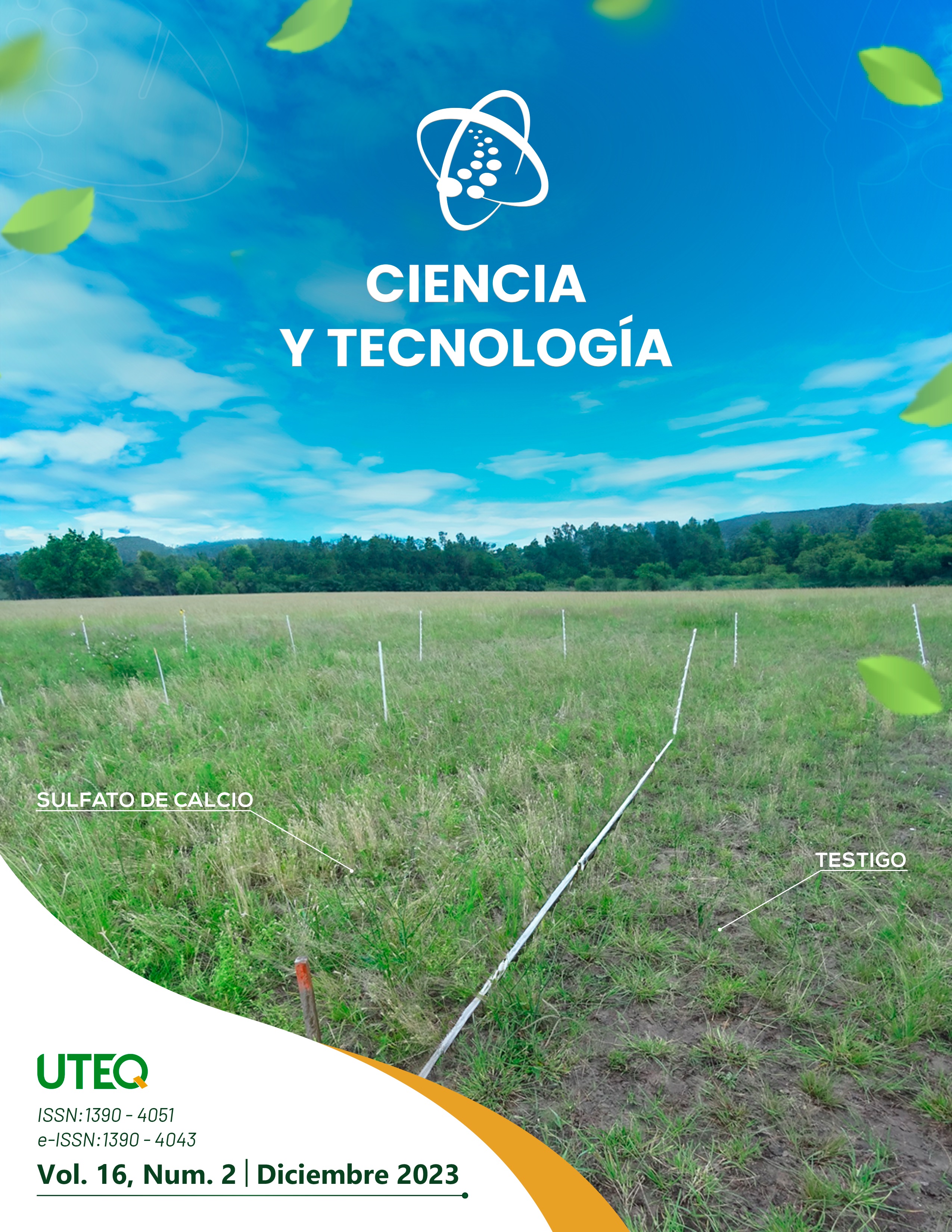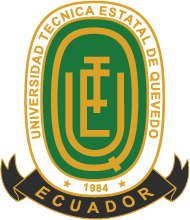Efecto de bioformulados bacterianos como controladores de Radopholus similis y potenciadores del desarrollo de plántulas de banano (Musa acuminata) cultivar Williams
DOI:
https://doi.org/10.18779/cyt.v16i2.705Palabras clave:
Microbiota, Acinetobacter calcoaceticus, Pseudomonas protegens, CFU/mL-1, nematicidaResumen
La alta incidencia del nematodo barrenador R. similis en el cultivo de banano ha impulsado el empleo continuo de nematicidas, como la única solución eficaz, pero poco sostenible ante la microbiota y fertilidad de los suelos. Como alternativa biológica la actividad biocontroladora de las PGPRs surten el efecto supresor ante grandes poblaciones nematológicas. Como blanco de estudio se evaluó el efecto de bioformulados bacterianos en el control de R. similis y potenciador al desarrollo de plántulas de banano cultivar Williams. Se empleó cinco factores de estudio: Tres bioformulados elaborados con diferentes componentes, los cuales se inoculó en combinación 4 cepas PGPRs Acinetobacter calcoaceticus BMR 2-12, Serratia marcescens PM 3-8, Pseudomonas protegens CHA0 y Enterobacter asburiae PM 3-14; Nematicida y Sin PGPRs para sus evaluaciones biocontroladora y promotoras en presencia del nematodo aplicado en poblaciones iniciales entre 10,000 – 15,000 más cuatro repoblamientos de 8,000 – 10,000 en plántulas de banano. El factor biocontrolador del Bioformulado-1 con cargas CFU/mL-1 de 9.70X109 obtuvo mayor efectividad en la presencia de R. similis reduciendo a 1,000/100 g de raíz, contrarrestando su incidencia de daños a 12.28 %. Así mismo el efecto de los Bioformulados mejoró varios parámetros de crecimiento vegetal, implicando al aumento de la altura de planta con 42.74 y 42.42 cm (Bio- 1 y 3); mayor número de hojas de 5.80 y 5.40 (Bio-1 y 2); longitud radicular con 35.64 cm (Bio-3), revelando poseer altos beneficios hacia la agricultura sostenible.
Descargas
Citas
Almaghrabi, O. A., Massoud, S. I., y Abdelmoneim, T. S. (2013). Influence of inoculation with plant growth promoting rhizobacteria (PGPR) on tomato plant growth and nematode reproduction under greenhouse conditions. Saudi journal of biological sciences, 20(1), 57-61. https://doi.org/10.1016/j.sjbs.2012.10.004.
Amogou, O., Dagbénonbakin, G., Nadège Adoukè, A., Pacôme Agossou, N., Pacôme Agossou, N., Marcel Yévèdo, A., y Baba-Moussa, L. (2019). Applying Rhizobacteria on Maize Cultivation in Northern Benin: Effect on Growth and Yield. Agricultural Sciences, 10, 763-782. https:// doi.org/10.4236/as.2019.106059.
Bauer, A. W., Kirby, W. M. M., Sherris, J. C., y Turck, M. (1966). Antibiotic susceptibility testing by a standardized single disk method. American journal of clinical pathology, 45(4_ts), 493-496.
Cabrera, J. B. Z., Guerrero, J. N. Q., y Batista, R. M. G. (2020). La producción de banano en la Provincial de El Oro y su impacto en la agrobiodiversidad. Revista Metropolitana de Ciencias Aplicadas, 3(3), 189-195.
Castro, L., Flores, L., y Uribe, L. (2011). Efecto del vermicompost y quitina sobre el control de Meloidogyne incognita en tomate a nivel de invernadero. Agronomía Costarricense, 35(2), 21-32.
Chabrier, C., y Queneherve, P. (2003). Control of the burrowing nematode (Radopholus similis Cobb) on banana: impact of the banana field destruction method on the efficiency of the following fallow. Crop protection, 22(1), 121-127.
Chaves, P., Pocasangre, L., Elango, F., Rosales, F. y Sikora, R. (2009). Combining endophytic fungi and bacteria for the biocontrol of Radopholus similis (Cobb) Thorne and for effects on plant growth. Scientia Horticulturae, 122(3), 472–478. https://doi.org/10.1016/j.scienta.2009.05.025.
Chen, W., Laevens, S., Lee, T., Coenye, T., De Vos. P., Mergeay, M., y Vandamme, P. (2001). Ralstonia taiwanensis sp. nov., isolated from root nodules of Mimosa species and sputum of a cystic fibrosis patient. International journal of systematic and evolutionary microbiology, 51(Pt 5), 1729–1735. https://doi.org/10.1099/00207713-51-5-1729.
Chitamba, J., Manjeru, P., Chinheya, C. C., y Handiseni, M. (2014). Evaluation of legume intercrops on the population dynamics and damage level of burrowing nematode (Radopholus similis) in banana (Musa spp.). Archives of Phytopathology and Plant Protection, 47(6), 761-773. https://doi.org/10.1080/03235408.2013.821759.
Crespo-Clas, Á. M., Canchignia-Martínez, H. F., y Fiallos, F. R. G. (2023). Nematodes and root system are affected by rhizobacterial consortium in the third generation of commercial banana plants. Revista de agricultura neotropical, 10(3), e7725-e7725.
De Weert, S., Dekkers, C., Bitter, W., Tuinman, S., Wijfjes. A., van Boxtel, R y Lugtenberg B. (2006) The two- component Colr/s system of Pseudomonas fluorescens WCS365 plays a role in rhizosphere competence through maintaining the structure and function of the outer membrane. FEMS microbiology ecology, 58(2), 205–213. https://doi.org/10.1111/j.1574-6941.2006.00158.x
Dennis, P., Miller, A., y Hirsch, P. (2010). Are root exudates more important than other sources of rhizodeposits in structuring rhizosphere bacterial communities?. FEMS microbiology ecology, 72(3), 313-327. https://doi. org/10.1111/j.1574-6941.2010.00860.x.
Döbereiner J. (1992). History and new perspectives of diazotrophs in association with nonleguminous plants. Symbiosis 13,1-13.
Garrido, F., Cárdenas, M., Bonilla, R., y Baldani, L. (2010). Efecto de los factores edafoclimaticos y la especie de pasto en la diversidad de bacterias diazotroficas. Pastos y Forrajes, 33(4):1-12.
Jones, D. L., Hodge, A., y Kuzyakov, Y. (2004a). Plant and mycorrhizal regulation of rhizodeposition. New phytologist, 163(3), 459-480. https://doi.org/10.1111/ j.1469-8137.2004.01130.x.
Jones, L., Nguyen C. y Finlay R. (2009b) Carbon flow in the rhizosphere: carbon trading at the soil–root interface. Plant Soil, 321, 5–33. https://doi.org/10.1007/s11104-009-9925-0.
Kalay Sari, N., Kafkas, N. E., Oguz, I., y Ozarslandan, A. (2023). Effect of Sources of Nutrients and Nematicide Application on Fruit Yield, Quality and Nematode Density in Polyhouse Grown Banana (Musa AAA var.‘Azman’). Erwerbs-Obstbau, 1-14.
Khalilian, A., Sullivan, M. J., Mueller, J. D., Shiralipour, A., Wolak, F. J., Williamson, R. E., y Lippert, R. M. (2002). Effects of surface application of MSW compost on cotton production–soil properties, plant responses, and nematode management. Compost science and utilization, 10(3), 270-279. https://doi.org/10.1080/1065 657X.2002.10702089.
King, E. O., Ward, M. K., y Raney, D. E. (1954). Two simple media for the demonstration of pyocyanin and fluorescin. The Journal of laboratory and clinical medicine, 44(2), 301-307.
Kosma, P., Ambang, Z., Begoude, B. A. D., Ten Hoopen, G. M., Kuaté, J., y Akoa, A. (2011). Assessment of nematicidal properties and phytochemical screening of neem seed formulations using Radopholus similis, parasitic nematode of plantain in Cameroon. Crop protection, 30(6), 733-738. https://doi.org/10.1016/j. cropro.2011.02.026.
Kumar, A., Singh, A. K., y Choudhary, K. K. (Eds.). (2019). Role of plant growth promoting microorganisms in sustainable agriculture and nanotechnology. Woodhead Publishing. https://doi.org/10.1016/B978-0-12-817004- 5.00001-4
Landa, B. B., Mavrodi, O. V., Raaijmakers, J. M., McSpadden Gardener, B. B., Thomashow, L. S., y Weller, D. M. (2002). Differential ability of genotypes of 2, 4-diacetylphloroglucinol-producing Pseudomonas fluorescens strains to colonize the roots of pea plants. Applied and Environmental Microbiology, 68(7), 3226-3237. https://doi.org/10.1128/AEM.68.7.3226-3237.2002.
conditions on hydrogen production from starch using anaerobic bacteria. Journal of bioscience and bioengineering, 98(4), 251-256. https://doi.org/10.1016/ S1389-1723(04)00277-4.
Liu, L., Huang, X., Zhang, J., Cai, Z., Jiang, K., y Chang, Y. (2020b). Deciphering the relative importance of soil and plant traits on the development of rhizosphere microbial communities. Soil Biology and Biochemistry, 148, 107909. https://doi.org/10.1016/j.soilbio.2020.107909.
Manzo-Sánchez, G., Orozco-Santos, M., Martínez-Bolaños, L., Garrido-Ramírez, E., y Canto-Canche, B. (2014). Diseases of quarantine and economic importance in banana tree (Musa sp.) in México. Revista mexicana de fitopatología, 32(2), 89-107.
Martínez, H. F., Chávez-Arteaga, K., Guato-Molina, J., Peñafiel-Jaramillo, M., y Mestanza-Uquillas, C. (2018). Bacterias fluorescentes productoras de metabolitos antagónicos de cultivares nativos de Musa sp. y su diversidad filogenética al gen ARNr 16S. Ciencia y Tecnología, 11(2), 17-29. https://doi.org/10.18779/cyt. v11i2.232
Mavrodi, O., Mavrodi, D., Park, A., Weller, D., y Thomashow, L. (2006). The role of dsbA in colonization of the wheat rhizosphere by Pseudomonas fluorescens Q8r1-96. Microbiology, 152(3), 863-872. https://doi.org/10.1099/ mic.0.28545-0.
McDougal, B., y Rovira A. (1970) Sites of exudation of C-14- labelled compounds from wheat roots. New Phytol 69(4), 999–1003. https://doi.org/10.1111/j.1469-8137.1970. tb02479.x.
Mendoza, A., Kiewnick, S., y Sikora A. (2008). In vitro activity of Bacillus firmus against the burrowing nematode Radopholus similis, the root-knot nematode Meloidogyne incognita and the stem nematode Ditylenchus dipsaci. Biocontrol Science and Technology, 18(4), 377–389. https://doi.org/10.1080/09583150801952143.
Norton, J., Smith J., y Firestone M. (1990) Carbon flow in the rhizosphere of Ponderosa pine-seedlings. Soil Biology and Biochemistry 22(4), 449–455. https://doi. org/10.1016/0038-0717(90)90177-2.
Nyang’au, D., Atandi, J., Cortada, L., Nchore, S., Mwangi, M., y Coyne, D. (2021). Diversity of nematodes on banana (Musa spp.) in Kenya linked to altitude and with a focus on the pathogenicity of Pratylenchus goodeyi. Nematology, 24(2), 137-147.
Prashar, P., Kapoor, N., y Sachdeva, S. (2014). Rhizosphere: its structure, bacterial diversity and significance. Reviews in Environmental Science and Bio/Technology, 13, 63-77. https://doi.org/10.1007/s11157-013-9317-z.
Riascos Ortíz, D. (2014). Los nematodos fitopatógenos como inductores de estrés biótico en plantas. Revista de Investigación Agraria y Ambiental, 5(2), 259-267.
Ryan, P. R., Delhaize, E., y Jones, D. L. (2001). Function and mechanism of organic anion exudation from plant roots. Annual review of plant biology, 52(1), 527-560.
Santo, F. B. M., Montealegre, V. J. G., Romero, H. C., y Minuche, P. R. (2022). Análisis de la producción y exportaciones del sector bananero ecuatoriano en el periodo 2010-2020. Polo del Conocimiento: Revista científico-profesional, 7(8), 650-664.
Singh, S., Singh, B., y Singh, A. P. (2015). Nematodes: A threat to sustainability of agriculture. Procedia Environmental Sciences, 29, 215-216. https://doi.org/10.1016/j. proenv.2015.07.270.
Stover, R. H. (1966). Fungi associated with nematode and non- nematode lesions on banana roots. Canadian Journal of Botany, 44(12), 1703-1710. https://doi.org/10.1139/ b66-183.
Tsavkelova, E. A., Klimova, S. Y., Cherdyntseva, T. A., y Netrusov, A. I. (2006). Microbial producers of plant growth stimulators and their practical use: a review. Applied biochemistry and microbiology, 42, 117-126. https://doi.org/10.1134/S0003683806020013.
Vaca, E., Gaibor, N., y Kovács, K. (2020). Analysis of the chain of the banana industry of Ecuador and the European market. Applied Studies in Agribusiness and Commerce, 14(1-2), 57-65.
Vanegas, A. M. M., Arenas, J. W., Omar Ocampo Jiménez, O., y Zulma Monsalve Fonnegra, I. (2023). Nematicidal activity and in vitro radical scavenging from Piper cumbricola and Piper eriopodon. Biocatalysis and Agricultural Biotechnology, 47, 102595.
Publicado
Cómo citar
Número
Sección
Licencia
Derechos de autor 2023 Cristhian John Macías Holguín, Flavio Cesar Valarezo Padilla , Dayanara Nicolle Tapia Quintana, Hayron Fabricio Canchignia Martínez , Ángel Virgilio Cedeño Moreira, Erick García Intriago

Esta obra está bajo una licencia internacional Creative Commons Atribución-NoComercial-CompartirIgual 4.0.
Licensing Agreement
This journal provides free access to its content through its website following the principle that making research available free of charge to the public supports a larger exchange of global knowledge.
Web content of the journal is distributed under a Attribution-NonCommercial-ShareAlike 4.0 International.
Authors may adopt other non-exclusive license agreements for the distribution of the version of the published work, provided that the initial publication in this journal is indicated. Authors are allowed and recommended to disseminate their work through the internet before and during the submission process, which can produce interesting exchanges and increase citations of the published work.











